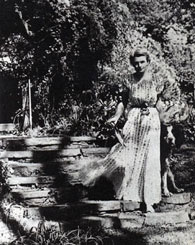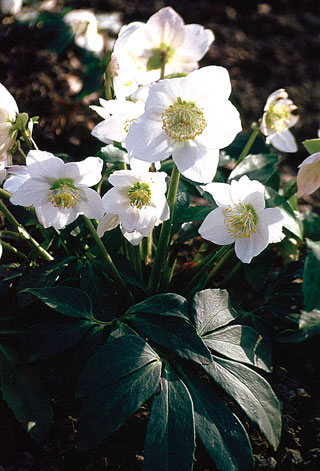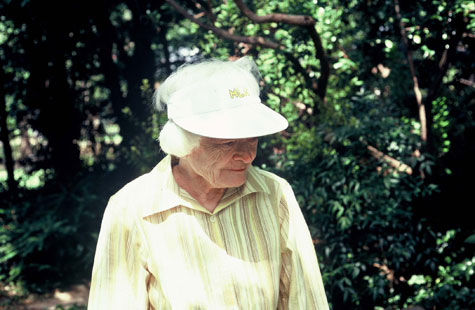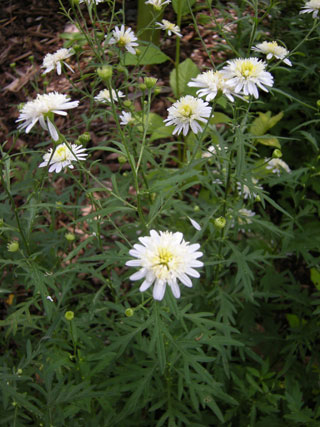Human Flower Project
From Elizabeth Lawrence: Past, Passalong, and Future
Allen Bush remembers his correspondence and visit with famed Southern gardener Elizabeth Lawrence—and her gift of a “reasonable” plant.

Lawrence at her garden gate with Clematis armandii 1957
Photo: Charlotte Observer
“This is the gate of my garden. I invite you to enter in: not only into my garden, but into the world of gardens – a world as old as the history of man, and as new as the latest contribution of science; a world of mystery, adventure and romance; a world of poetry and philosophy; a world of beauty, and a world of work.”
from Elizabeth Lawrence’s first Charlotte Observer column in 1957
By Allen Bush
Nursery folks – God bless ‘em – stoke the dreams of plants that can’t-go-wrong. Gardening requires eternal hope. Fortunately, there are ornamental garden plants that approach being bullet-proof. These are passalong plants that needn’t cost a thing – beloved gifts from the plant kingdom shared from one gardener to another.
The passalong routine among friends and acquaintances goes like this: “You’ve got to try it!” And before you have a chance to think twice, this is followed with: “This has grown great for years!” The generous gift offer of a never-grown-before plant is temptation too great to resist. I’ve been the beneficiary of this unrestrained enthusiasm more times than I deserve.
I wander through my garden every day and think of these pass-alongers. It’s a packed house. There are dozens of tough as nails plants that include an aster from Raydon Alexander, a black gum from Mike Hayman and a gladiolus from Dick Bir. None has been with me as long as the Oxford Orphanage Plant, a gift from Elizabeth Lawrence.
I found Elizabeth Lawrence’s Southern Gardens—A Handbook for the Middle South at the Asheville, North Carolina, library in the early 1980s. The book, first published in 1942, is a wonderful garden tale and plant resource. I’d never heard of her.
Writer Eudora Welty was a friend and admirer. Both she and Elizabeth were single daughters who dutifully shared the burden of caring for widowed mothers. Katharine White, who sang Elizabeth’s praises in The New Yorker, corresponded with her for over twenty years. Emily Herring Wilson edited Two Gardeners: Katharine S. White and Elizabeth Lawrence – A Friendship in Letters, published in 2002.
 Elizabeth Lawrence in Raleigh, North Carolina, 1932
Elizabeth Lawrence in Raleigh, North Carolina, 1932
Photo: Bayard Wooten, North Carolina Collection, University of North Carolina
I discovered in Elizabeth someone so uniquely important that I couldn’t stop thinking about her. The 1932 Bayard Wooten photo of her in Southern Garden depicted a garden Goddess, standing regally in a long flowing dress, next to her spaniel “Mr Cayce.” The black and white image has stayed with me for years.
The gardener’s “middle south” stretched farther than traditional Southern boundaries, as Elizabeth explained: “…(from) the Eastern Shore of Maryland, taking in the Gulf Stream Nursery at Wachapreague (Virginia), and coming down through Tidewater Virginia to Piedmont North Carolina.” It stretched, she wrote, “From there… to Columbia, South Carolina, and goes on across to Atlanta, Birmingham, Jackson, Shreveport and on to El Paso, and wanders up the west coast and into Canada.” This was a generalized geographic area where winter cold averages might be similar but other seasonal variables such as summer heat could be very different.
I wasn’t a part of her middle south but I wasn’t far from it. I lived nearby in the mountains, only a few hours away, but was eager to try plants she described so temptingly: “Of all the winter flowers the Algerian Iris, I. unguicularis, is most to be desired for delicacy of texture and coloring, and for fragrance. In general it is one of the most dependable bloomers, although Mr. Busbee (North Carolina) had found it freakish, blooming one year in October and another not until March. With me it does not bloom until the first of the year, and not at all until the plants become established. On the other hand Miss Jekyll (Godalming, Surrey, England) counted on flowers from November to April, and Billy Hunt reports the same season for Chapel Hill (North Carolina). One bleak day I saw Billy’s patch in full bloom under bare-branched oak trees. It was as if a wand had been waved. I wonder now if I am telling the truth. But there they were, dozens of them, enough to pick handfuls and still leave a bed of tender lavender.”
 Helleborus niger:
Helleborus niger:
an “aura of good and evil”
Photo: Jelitto Perennial Seeds
She warned me, writing about the Christmas Rose, Helleborus niger, “…its pure white flowers and poisonous black root, has an aura of good and evil. The meaning of the name is lost in time, but it is thought to be ‘food to kill.’ The drug made from its roots has been in use as a remedy and a poison since the legendary days when a king of Argos rewarded with a large portion of his kingdom, the physician who cured his daughters’ madness by this means.”
A few years later I mentioned Elizabeth’s name to a gardening acquaintance in Asheville who said she’d relocated to Charlotte in 1948 from her original Raleigh garden. Elizabeth was alive! I’d imagined she was long gone. I was excited also to hear she welcomed occasional guests. But I worried a Goddess bigger than life might be intimidating. Her words – not priggish at all – betrayed my notion: “I am not writing for those who want to be told how to grow rare and difficult plants, but for those who want to grow a variety of plants in an average garden, giving them a reasonable amount of care and spending a reasonable amount of intelligence upon them.”
Through a friend of a friend, a call was made and Elizabeth agreed to meet me early one Saturday morning Labor Day weekend in September 1982. I drove down the night before so I wouldn’t be late (she wouldn’t suffer tardy fools would she?). I arrived on time and was greeted by a speck of a woman who was anything but intimidating. Before we headed-off for a walk around she offered—and I accepted at mid-morning—a glass of sweet sherry.

Elizabeth Lawrence in her Charlotte, North Carolina, garden, 1982
Photo: Allen Bush
It doesn’t do sufficient credit to call Elizabeth’s suburban garden—or my recollection of it—a formal design. The bones were there but there was a playful exuberance and lack of stiffness (the sherry only enhanced my impression). The garden certainly wasn’t fussy. I remember the gate covered with the evergreen Clematis armandii and was introduced to Butcher’s Broom, Ruscus aculeatus, a low-growing evergreen, “so called because of being used in England as a brush to clean the meat blocks….” The place needed a little attention, but a day or two’s work would have gotten it ship-shape. Elizabeth was approaching 80, and could no longer deal with all the maintenance. And, though apologetic about the few shortcomings – as most gardeners are about their own gardens—she seemed not to care that it wasn’t neat as a pin. She was curious about new plants and was particularly interested in my young nursery. Elizabeth was encouraging and treated me with far more dignity than I had expected.
At some point she stopped before a curious semi-double white flowering daisy-like perennial and asked if I knew it. I did not. She called it Asteromoea mongolica – a bewildering name that left me stumped. She offered a piece, encouraging me along the lines of – you guessed it: “You’ve got to try it…This has grown great for years.”
I took the piece back to western North Carolina. The dainty little white double daisies were not like blowsy, puffed-up-pom-pom chrysanthemums. Indeed, the plant could be easily overlooked, but it flowered intermittently over the entire next summer, regularly catching my attention. It grew thirty inches high and wide, was sturdy and handled full sun, but seemed happiest in part-shade in the South. Elizabeth’s gift came back every year and proved cold hardy as far north as Minnesota. “If plants are miffy, let them go,” Elizabeth wrote. This was not a “miffy” plant.
There was nary a word written anywhere about Asteromoea. I wrote and thanked Elizabeth for the visit and the gift of the passalong plant. She wrote back, but her handwriting, described by Elizabeth’s biographer Emily Herring Wilson (No One Gardens Alone, 2004 ) as,“microscopic” started-off barely legible and ended as chicken scratch. Elizabeth outlined where she’d gotten the plant years before and established why she thought it was called Asteromoea mongolica. The plant seems to have been noticed first on the grounds of the old Oxford Orphanage in Oxford, North Carolina. I could never establish when it was first planted there or by whom.
 Kalimeris pinnatifida ‘Hortensis,’ found at the Oxford Orphanage in Oxford, NC, Elizabeth Lawrence’s gift
Kalimeris pinnatifida ‘Hortensis,’ found at the Oxford Orphanage in Oxford, NC, Elizabeth Lawrence’s gift
Photo: Allen Bush
I eventually found a reference listing Asteromoea as a synonym, under Kalimeris, in Jisaburo Ohwi’s Flora of Japan. The 2009-2010 Royal Horticultural Plant Finder has established – for the moment – that it is Kalimeris pinnatifida ‘Hortensis.’ Allan Armitage, author, gardener and horticulture professor at the University of Georgia, said this about the Double Japanese Aster: “In talks I present or lists of plants I make, this plant goes near the top of ‘no-brainers’: one which can be planted without fear of failure.”
Elizabeth’s gift grew beautifully for fourteen years in my North Carolina mountain garden. I purchased the Algerian Iris a few times and failed miserably with each attempt. I blame a few cold winters. The Christmas Rose, Helleborus niger, though seldom in flower at Christmas, blooms wonderfully when we get a warm spell.
I packed-up a truck load of plants I couldn’t be without when I moved back to Kentucky in 1995. There were some rarities like a tiny arum and a lovely yellowing flowering yellow Lenten Rose (Helleborus x orientalis), and there were plenty of plants that held great sentimental values, probably not worth a dime to anyone else. Elizabeth’s common passalong plant was among the most prized.
The Oxford Orphanage Plant looks a little forsaken this summer. Not orphaned exactly, but overgrown down near the alley by a Chinese Sweetshrub, Calycanthus sinensis, and a hemp plant look-alike, Datisca cannabina. The latter used to fool the neighborhood teenagers (or maybe it was their parents?) who occasionally would strip leaves for a useless smoke. I doubt the kids or the grown-ups paid much attention to Elizabeth’s plant. I need to move it to a new spot when it cools down, someplace with a bit more sun. I like to take care of my friends.
Comments
Would Elizabeth’s plant grow indoors in NYC? A great story; thanks Allen.
I love this story! My garden is full of plants from
friends and family. It is why I love gardening so much.
I am especially fond of plants that are not ‘miffy’.
Thanks for this grand tale of Elizabeth Lawrence.
The welcoming photo says it all!
Thank you Carol. And thanks Georgia. I haven’t grown the plant inside and imagine if it were kept indoors in winter, it would look so scrawny that it might not brighten too many gray February days. I suspect it will need some cold. It goes dormant and disappears in winter outdoors and then comes back to life in spring.


Thank you, I love Elizabeth Lawrence’s writings and enjoyed this post.